2008 SUBARU OUTBACK climate control
[x] Cancel search: climate controlPage 190 of 444

4-12Climate control
–Interior air temperature sensor: on the
side of the driver-side part of the center panel – Outside temperature sensor: behind
front grille. Operating tips for heater and
air conditioner &
Cleaning ventilator grille
Always keep the front ventilator inlet grille
free of snow, leaves, or other obstructions
to ensure efficient heating and defrosting.
Since the condenser is located in front of
the radiator, this area should be kept clean
because cooling performance is impaired
by any accumulation of insects and leaves
on the condenser. &Efficient cooling after parking
in direct sunlight
After parking in direct sunlight, drive with
the windows open for a few minutes to
allow outside air to circulate into the heated interior. This results in quicker
cooling by the air conditioner. Keep the
windows closed during the operation of
the air conditioner for maximum cooling
efficiency. &
Lubrication oil circulation in
the refrigerant circuit
Operate the air conditioner compressor at
a low engine speed (at idle or low driving
speeds) a few minutes each month during
the off-season to circulate its oil. & Checking air conditioning
system before summer sea-son
Check the air conditioner unit for refriger-
ant leaks, hose conditions, and proper
operation each spring. Have your
SUBARU dealer perform this check. & Cooling and dehumidifying in
high humidity and low tem-
perature weather condition
Under certain weather conditions (high
relative humidity, low temperatures, etc.) a
small amount of water vapor emission
from the air outlets may be noticed. This
condition is normal and does not indicate
any problem with the air conditioningsystem.
Page 191 of 444
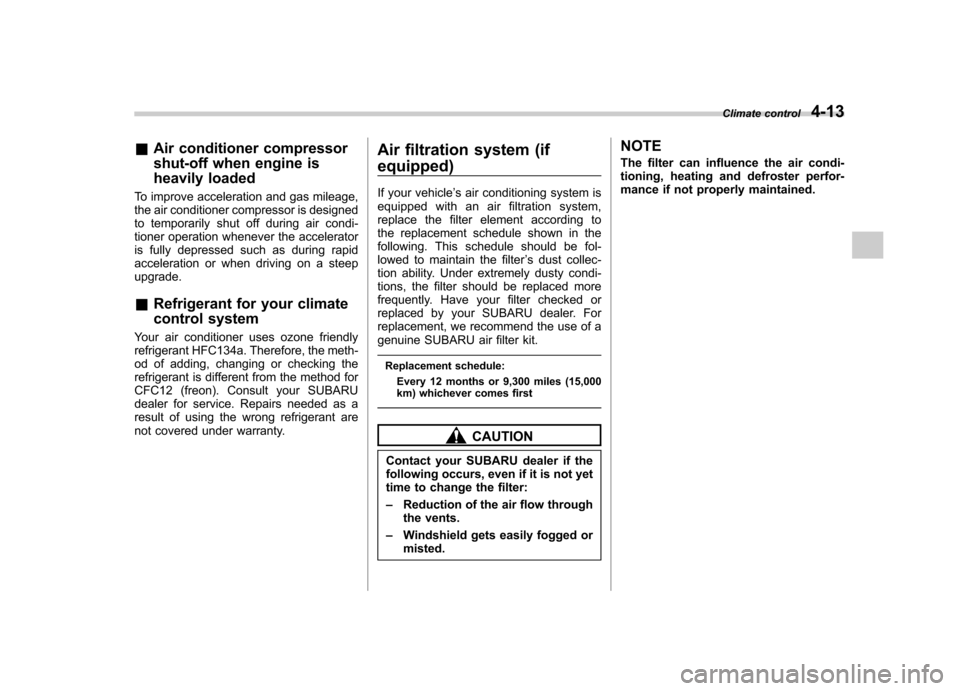
&Air conditioner compressor
shut-off when engine is
heavily loaded
To improve acceleration and gas mileage,
the air conditioner compressor is designed
to temporarily shut off during air condi-
tioner operation whenever the accelerator
is fully depressed such as during rapid
acceleration or when driving on a steepupgrade. & Refrigerant for your climate
control system
Your air conditioner uses ozone friendly
refrigerant HFC134a. Therefore, the meth-
od of adding, changing or checking the
refrigerant is different from the method for
CFC12 (freon). Consult your SUBARU
dealer for service. Repairs needed as a
result of using the wrong refrigerant are
not covered under warranty. Air filtration system (if equipped)
If your vehicle
’s air conditioning system is
equipped with an air filtration system,
replace the filter element according to
the replacement schedule shown in the
following. This schedule should be fol-
lowed to maintain the filter ’s dust collec-
tion ability. Under extremely dusty condi-
tions, the filter should be replaced more
frequently. Have your filter checked or
replaced by your SUBARU dealer. For
replacement, we recommend the use of a
genuine SUBARU air filter kit.
Replacement schedule: Every 12 months or 9,300 miles (15,000
km) whichever comes first
CAUTION
Contact your SUBARU dealer if the
following occurs, even if it is not yet
time to change the filter: – Reduction of the air flow through
the vents.
– Windshield gets easily fogged ormisted. NOTE
The filter can influence the air condi-
tioning, heating and defroster perfor-
mance if not properly maintained.
Climate control
4-13
Page 227 of 444
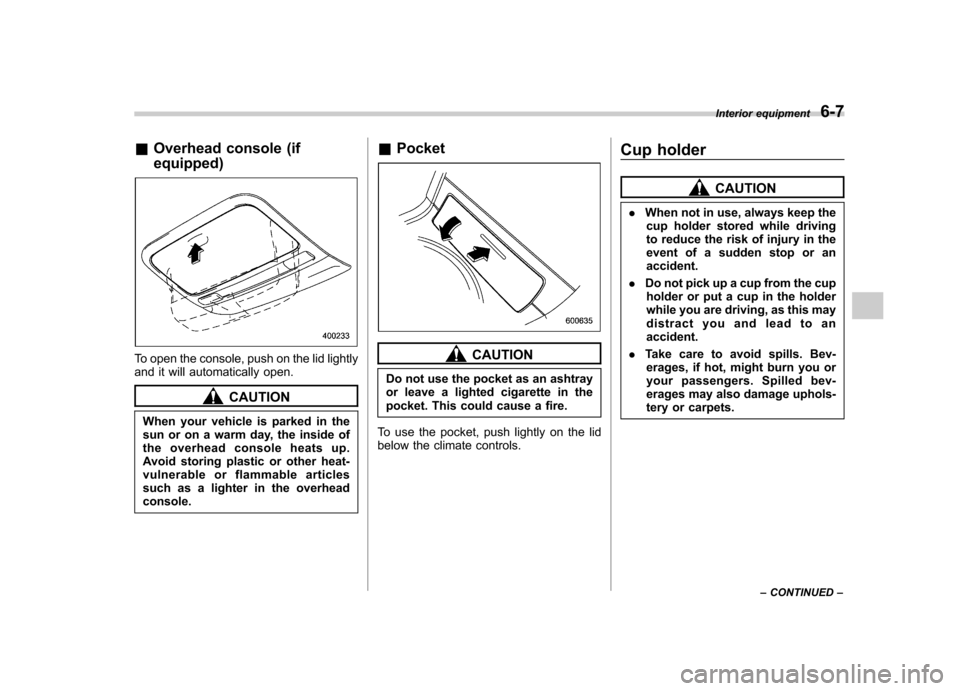
&Overhead console (if equipped)
To open the console, push on the lid lightly
and it will automatically open.
CAUTION
When your vehicle is parked in the
sun or on a warm day, the inside of
the overhead console heats up.
Avoid storing plastic or other heat-
vulnerable or flammable articles
such as a lighter in the overheadconsole. &
Pocket
CAUTION
Do not use the pocket as an ashtray
or leave a lighted cigarette in the
pocket. This could cause a fire.
To use the pocket, push lightly on the lid
below the climate controls. Cup holder
CAUTION
. When not in use, always keep the
cup holder stored while driving
to reduce the risk of injury in the
event of a sudden stop or anaccident.
. Do not pick up a cup from the cup
holder or put a cup in the holder
while you are driving, as this may
distract you and lead to anaccident.
. Take care to avoid spills. Bev-
erages, if hot, might burn you or
your passengers. Spilled bev-
erages may also damage uphols-
tery or carpets. Interior equipment
6-7
– CONTINUED –
Page 341 of 444

Exterior care....................................................... 10-2
Washing ............................................................. 10-2
Waxing and polishing ......................................... 10-3
Cleaning aluminum wheels ................................. 10-3
Corrosion protection .......................................... 10-4
Most common causes of corrosion ..................... 10-4
To help prevent corrosion ................................... 10-4 Cleaning the interior
.......................................... 10-5
Seat fabric ......................................................... 10-5
Leather seat materials ........................................ 10-5
Synthetic leather upholstery ............................... 10-5
Climate control panel, audio panel, instrument panel, console panel, switches, combination
meter, and other plastic surface ....................... 10-5
Navigation monitor (if equipped) ........................... 10-6
Appearance care
10
Page 345 of 444
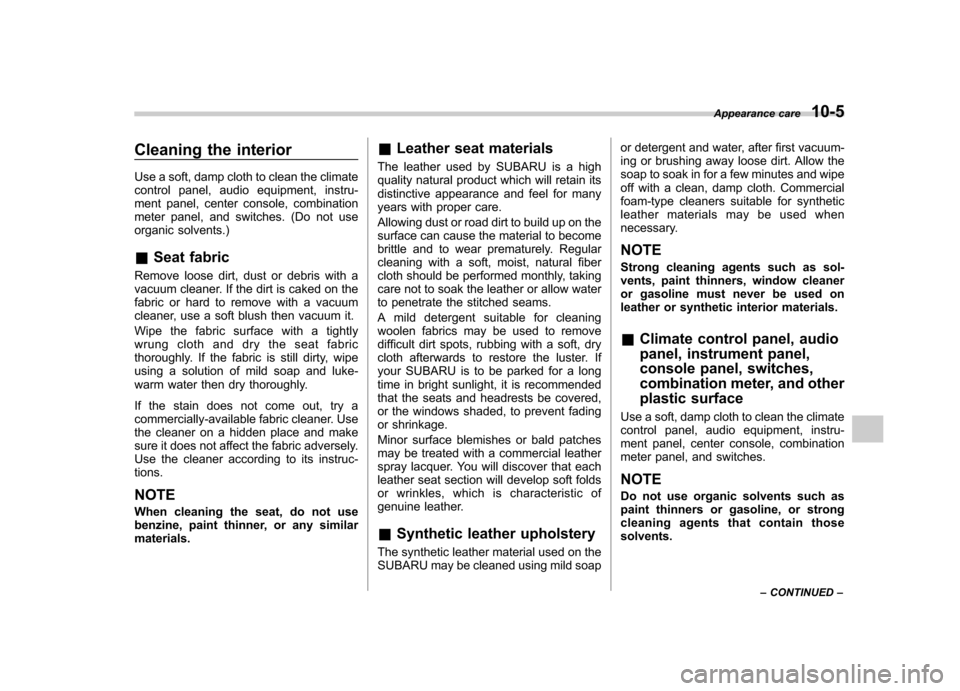
Cleaning the interior
Use a soft, damp cloth to clean the climate
control panel, audio equipment, instru-
ment panel, center console, combination
meter panel, and switches. (Do not use
organic solvents.) &Seat fabric
Remove loose dirt, dust or debris with a
vacuum cleaner. If the dirt is caked on the
fabric or hard to remove with a vacuum
cleaner, use a soft blush then vacuum it.
Wipe the fabric surface with a tightly
wrung cloth and dry the seat fabric
thoroughly. If the fabric is still dirty, wipe
using a solution of mild soap and luke-
warm water then dry thoroughly.
If the stain does not come out, try a
commercially-available fabric cleaner. Use
the cleaner on a hidden place and make
sure it does not affect the fabric adversely.
Use the cleaner according to its instruc-tions. NOTE
When cleaning the seat, do not use
benzine, paint thinner, or any similarmaterials. &
Leather seat materials
The leather used by SUBARU is a high
quality natural product which will retain its
distinctive appearance and feel for many
years with proper care.
Allowing dust or road dirt to build up on the
surface can cause the material to become
brittle and to wear prematurely. Regular
cleaning with a soft, moist, natural fiber
cloth should be performed monthly, taking
care not to soak the leather or allow water
to penetrate the stitched seams.
A mild detergent suitable for cleaning
woolen fabrics may be used to remove
difficult dirt spots, rubbing with a soft, dry
cloth afterwards to restore the luster. If
your SUBARU is to be parked for a long
time in bright sunlight, it is recommended
that the seats and headrests be covered,
or the windows shaded, to prevent fading
or shrinkage.
Minor surface blemishes or bald patches
may be treated with a commercial leather
spray lacquer. You will discover that each
leather seat section will develop soft folds
or wrinkles, which is characteristic of
genuine leather. & Synthetic leather upholstery
The synthetic leather material used on the
SUBARU may be cleaned using mild soap or detergent and water, after first vacuum-
ing or brushing away loose dirt. Allow the
soap to soak in for a few minutes and wipe
off with a clean, damp cloth. Commercial
foam-type cleaners suitable for synthetic
leather materials may be used when
necessary. NOTE
Strong cleaning agents such as sol-
vents, paint thinners, window cleaner
or gasoline must never be used on
leather or synthetic interior materials. &
Climate control panel, audio
panel, instrument panel,
console panel, switches,
combination meter, and other
plastic surface
Use a soft, damp cloth to clean the climate
control panel, audio equipment, instru-
ment panel, center console, combination
meter panel, and switches. NOTE
Do not use organic solvents such as
paint thinners or gasoline, or strong
cleaning agents that contain thosesolvents. Appearance care
10-5
– CONTINUED –
Page 429 of 444
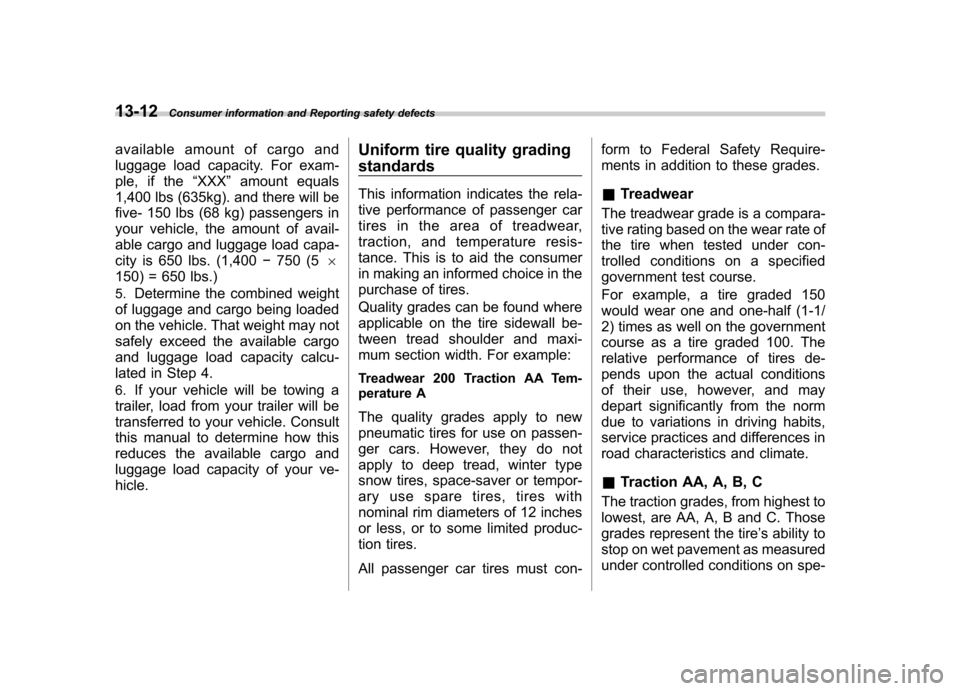
13-12Consumer information and Reporting safety defects
available amount of cargo and
luggage load capacity. For exam-
ple, if the “XXX ”amount equals
1,400 lbs (635kg). and there will be
five- 150 lbs (68 kg) passengers in
your vehicle, the amount of avail-
able cargo and luggage load capa-
city is 650 lbs. (1,400 �750 (5 6
150) = 650 lbs.)
5. Determine the combined weight
of luggage and cargo being loaded
on the vehicle. That weight may not
safely exceed the available cargo
and luggage load capacity calcu-
lated in Step 4. 6. If your vehicle will be towing a
trailer, load from your trailer will be
transferred to your vehicle. Consult
this manual to determine how this
reduces the available cargo and
luggage load capacity of your ve-hicle. Uniform tire quality grading standards
This information indicates the rela-
tive performance of passenger car
tires in the area of treadwear,
traction, and temperature resis-
tance. This is to aid the consumer
in making an informed choice in the
purchase of tires.
Quality grades can be found where
applicable on the tire sidewall be-
tween tread shoulder and maxi-
mum section width. For example:
Treadwear 200 Traction AA Tem-
perature A
The quality grades apply to new
pneumatic tires for use on passen-
ger cars. However, they do not
apply to deep tread, winter type
snow tires, space-saver or tempor-
ary use spare tires, tires with
nominal rim diameters of 12 inches
or less, or to some limited produc-
tion tires.
All passenger car tires must con-form to Federal Safety Require-
ments in addition to these grades. &
Treadwear
The treadwear grade is a compara-
tive rating based on the wear rate of
the tire when tested under con-
trolled conditions on a specified
government test course.
For example, a tire graded 150
would wear one and one-half (1-1/
2) times as well on the government
course as a tire graded 100. The
relative performance of tires de-
pends upon the actual conditions
of their use, however, and may
depart significantly from the norm
due to variations in driving habits,
service practices and differences in
road characteristics and climate. & Traction AA, A, B, C
The traction grades, from highest to
lowest, are AA, A, B and C. Those
grades represent the tire ’s ability to
stop on wet pavement as measured
under controlled conditions on spe-
Page 433 of 444

14-2Index
A
ABS (Anti-lock Brake System) ..................................... 7-35
Warning light ................................................. 3-34, 7-35
Accessories ....................................................... 5-4, 11-50
Accessory power outlet ................................................. 6-8
Active head restraint ..................................................... 1-7
Air cleaner element ................................................... 11-17
Air conditioner ............................................................. 4-7
Air filtration system ..................................................... 4-13
Air flow selection .......................................................... 4-2
Alarm system ............................................................ 2-15
All-Wheel Drive warning light ....................................... 3-36
Aluminum wheel cleaning ............................................ 10-3
Aluminum wheels ...................................................... 11-41
Antenna system ........................................................... 5-2
Anti-lock Brake System (ABS) ..................................... 7-35
Arming the system ..................................................... 2-16
Armrest ..................................................................... 1-12
AT OIL TEMPerature warning light ............................... 3-32
Audio control button ................................................... 5-26
Audio set .................................................................... 5-5
Auto-dimming mirror/compass ...................................... 3-55
Automatic climate control system ................................... 4-8
Automatic transmission 4-speed ................................................................ 7-18
5-speed ................................................................ 7-24
Capacities ............................................................. 12-4
Fluid .................................................................... 11-23
Manual mode ................................................ 7-21, 7-27
Selector lever ................................................ 7-18, 7-25
Shift lock release ........................................... 7-23, 7-29 SPORT
................................................................. 7-23
Temperature warning light (AT OIL TEMP) ................. 3-32
Automatic/Emergency Locking Retractor (A/ELR) ........... 1-14
B Battery .................................................................... 11-47
Jump starting ......................................................... 9-10
Replacement (Remote keyless entry system) .............. 2-8
Booster seat .............................................................. 1-33
Brake Booster ....................................................... 7-34, 11-31
Fluid ................................................................... 11-29
Pad and lining ...................................................... 11-33
Parking ....................................................... 7-45, 11-33
Pedal .................................................................. 11-31
System .................................................................. 7-34
Brake pedal
Free play ............................................................. 11-31
Reserve distance .................................................. 11-31
Brake system ............................................................. 7-34
Warning light .......................................................... 3-35
Braking ..................................................................... 7-34
Tips ...................................................................... 7-34
Breaking-in of new brake pads and linings ................... 11-33
Bulb Chart .................................................................... 12-9
Replacing ............................................................ 11-51
C Capacities ................................................................. 12-4
Page 434 of 444
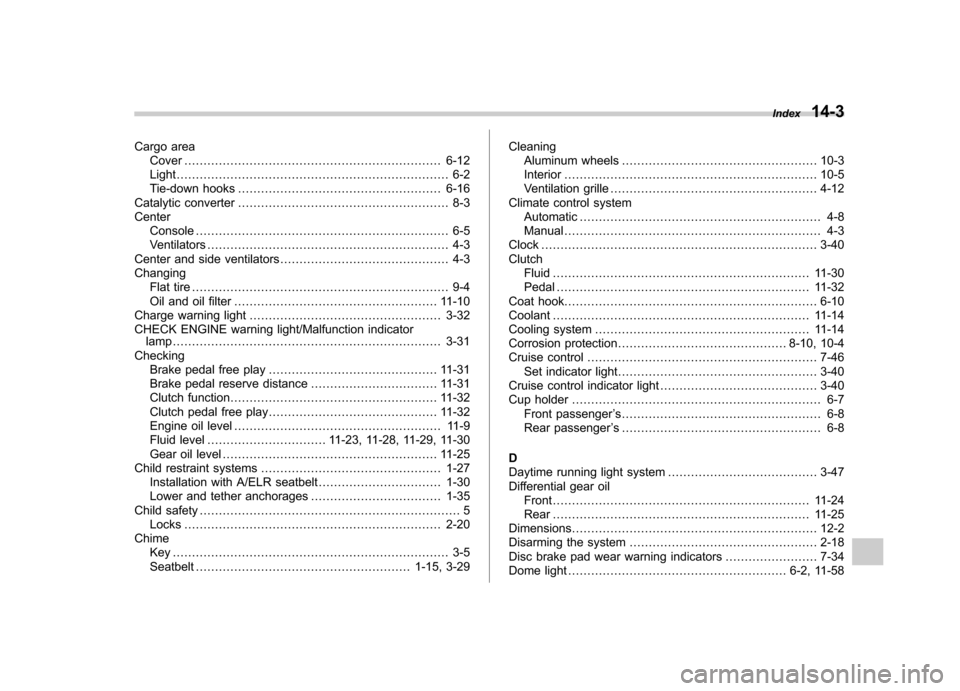
Cargo areaCover ................................................................... 6-12
Light ....................................................................... 6-2
Tie-down hooks ..................................................... 6-16
Catalytic converter ....................................................... 8-3
Center
Console .................................................................. 6-5
Ventilators ............................................................... 4-3
Center and side ventilators ............................................ 4-3
Changing Flat tire ................................................................... 9-4
Oil and oil filter ..................................................... 11-10
Charge warning light .................................................. 3-32
CHECK ENGINE warning light/Malfunction indicator lamp ...................................................................... 3-31
Checking
Brake pedal free play ............................................ 11-31
Brake pedal reserve distance ................................. 11-31
Clutch function ...................................................... 11-32
Clutch pedal free play ............................................ 11-32
Engine oil level ...................................................... 11-9
Fluid level ............................... 11-23, 11-28, 11-29, 11-30
Gear oil level ........................................................ 11-25
Child restraint systems ............................................... 1-27
Installation with A/ELR seatbelt ................................ 1-30
Lower and tether anchorages .................................. 1-35
Child safety .................................................................... 5
Locks ................................................................... 2-20
Chime
Key ........................................................................ 3-5 Seatbelt ........................................................ 1-15, 3-29 Cleaning
Aluminum wheels ................................................... 10-3
Interior .................................................................. 10-5
Ventilation grille ...................................................... 4-12
Climate control system Automatic ............................................................... 4-8
Manual ................................................................... 4-3
Clock ........................................................................ 3-40
Clutch
Fluid ................................................................... 11-30
Pedal .................................................................. 11-32
Coat hook. ................................................................. 6-10
Coolant ................................................................... 11-14
Cooling system ........................................................ 11-14
Corrosion protection ............................................ 8-10, 10-4
Cruise control ............................................................ 7-46
Set indicator light .................................................... 3-40
Cruise control indicator light ......................................... 3-40
Cup holder ................................................................. 6-7
Front passenger ’s.................................................... 6-8
Rear passenger ’s .................................................... 6-8
D
Daytime running light system ....................................... 3-47
Differential gear oil Front ................................................................... 11-24
Rear ................................................................... 11-25
Dimensions ................................................................ 12-2
Disarming the system ................................................. 2-18
Disc brake pad wear warning indicators ........................ 7-34
Dome light ......................................................... 6-2, 11-58 Index
14-3